Beat the Heat: Cold Injections in Gas Chromatography
In gas chromatography, heating the sample in the inlet can lead to sample losses and loss of quantitative reproducibility, but these problems can be avoided using cold sample introduction. This article describes various types of cold injection and how they can benefit the analyst.
In capillary gas chromatography (GC), we heat the most common inlets (split and splitless) to vaporize the samples and transfer them to the column. While heating and vaporizing the sample in the inlet presents the most convenient means for transferring it to the capillary column head, several problems that result in sample losses and quantitative reproducibility problems occur. We will briefly discuss the problems with sample heating in classical split and splitless inlets, followed by an introduction to cold inlets, which have been available since the 1970s, but are underutilized. Next, we will discuss modes of cold sample introduction, including cold on-column, cold split and splitless, cold splitless with solvent venting, and large volume injection. We will close with key points and considerations, and argue that users should consider cold injection as a purchase option or upgrade for any gas chromatograph.
This instalment of “GC Connections” follows up and builds on the basic discussion presented in LCGC Europe in May, 2018 (1).
Many gas chromatographers would agree that inlets and sample introduction are the most challenging aspects of capillary gas chromatography, and we see that most gas chromatographers are still using the same inlets (split and splitless) and techniques, especially injecting with a 10 µL syringe, developed in the 1950s and 1960s (2). We make a fundamental, yet incorrect, assumption that the inlet must be heated in order to rapidly vaporize the sample, mix it with the carrier gas, and transfer it to the column. This assumption led to the development of both the split and splitless techniques in common use today. It also leads to several of the main causes of reproducibility problems and the need for troubleshooting in gas chromatography.
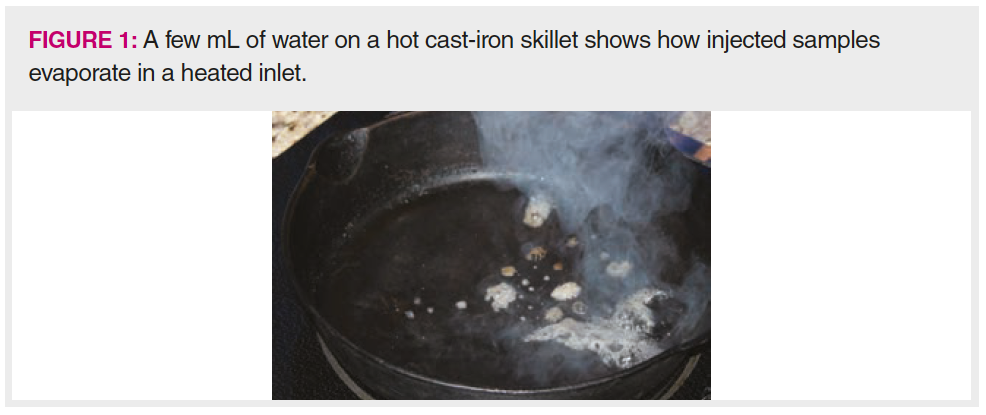
Figure 1, a photograph first published in the May, 2018 instalment of “GC Connections,” illustrates some of the key problems. It shows the result when a few millilitres of water (like a sample solvent) is transferred using a spoon to a hot cast iron skillet on a stove (like a heated inlet liner). The picture was taken a few seconds after the water was introduced to the skillet. There are several take-home points about hot sample injections from this photo.
- No matter how hot and massive the inlet, the solvent does not evaporate instantly. This is a major cause of discrimination, or the preferential loss of some analytes.
- The layer of gas between the solvent and the surface also causes some of the analytes to be exposed directly to the hot surface, causing analyte decomposition.
- In splitless inlets, the sample requires up to a minute or more to transfer to the column, leading to band broadening.
- Note the discolouration of the water on the surface. The solvent can actually re-introduce contaminants from a dirty inlet. This causes contamination or ghost peaks.
- While not shown here, some of the water remained in the spoon, analogous to a syringe. The syringe needle is also a leading cause of discrimination and apparent sample losses.
Although they are convenient to use, heated split and splitless inlets can clearly cause many problems and challenges for method development and analysis by GC. This is enough of a challenge that the book by Grob, the classic text on split and splitless inlets, is nearly 500 pages long (3)!
Figure 2 shows diagrams of the pressure, temperature and flows in classical split (Figure 2[a]) and splitless (Figure 2[b]) injections. These show the relative simplicity and convenience of the two techniques, and provide the main reason why there has been resistance in the community to others. In split injections (Figure 2[a]), once the split ratio (total flow) and column flow rate are set, none of the parameters change during the run. The inlet temperature is constant and hot throughout the injection and the analytical run (often 250 ºC), and the purge flow, through the inlet liner, is constant and high (often on the order of 100 mL/min). To save carrier gas, the gas saver feature on modern inlets can be used to reduce the purge flow once the injection process is complete. In splitless injections (Figure 2[b]), the purge flow through the inlet liner is low at the beginning of the run and at the injection. It stays low for a specified time, and then is rapidly raised by switching a solenoid valve. During the “purge‑off” time, vapours in the inlet liner are transferred slowly to the column, with no other outlet. The oven temperature starts low (this is a requirement in splitless injections) and a temperature programme is then performed. As in split injections, the purge flow can be reduced later in the run to save carrier gas. The added parameter of the purge valve starting “off” and coming “on” after a specified time is still relatively straightforward to optimize.
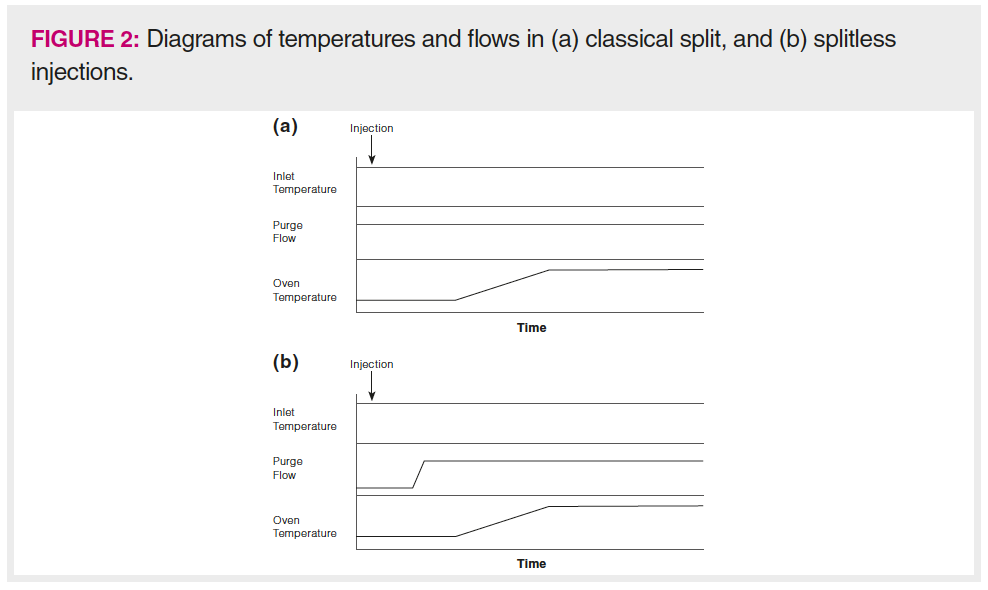
A solution to the problems with split and splitless injections has existed since the late 1970s with the invention of programmed temperature vaporization inlets, termed PTV, by Vogt (4,5). Major instrument vendors have offered PTV and cool-on column inlets as an add-on to new gas chromatographs, but they have never become popular. In the rest of this instalment, we will discuss the fundamentals of programmed temperature injections using PTV and cool on-column inlets, and follow up with key points and discussion that should lead you to consider cold inlets with your next GC.
Most of the instrument vendors and a few specialty vendors offer solutions for cold inlets in GC. Some vendors have their own terminology for the classical PTV inlet, some sticking with PTV, while others use “multi-mode inlet” or “cooled injection system.” Nearly all vendors use cool or cold on-column to describe their on-column inlet offerings. With varying capabilities, they all allow a user to inject a sample into a cooled inlet, and then rapidly heat the inlet to transfer the sample to the column. Following the injection and heated transfer, and before the next injection, the inlet is cooled by a jet of air, carbon dioxide or liquid nitrogen.
Cool On-Column
The simplest and least expensive means for cold injections is to add a cool on‑column inlet to the GC. This inlet, as the name implies, is cooled during injection, and allows sample to be injected directly onto the column. Following injection, the inlet (which includes the column head) is heated along with the column via temperature programming. The cool on-column inlet is the best of all inlets for ensuring that the entire sample that leaves the syringe needle reaches the column. However, it is the worst of all inlets for keeping the column clean; the entire sample, including matrix components that cause glass sleeves in other inlets to need replacement, reaches the column. Cool on-column is especially useful for “clean” samples in non-polar solvents, or solvents whose polarity closely matches that of the column. A retention gap, a short (typically 5 m or so) length of uncoated fused-silica tubing is often used between the inlet and analytical column, to provide a polar surface to allow the use of polar solvents, and an easily replaced guard column to protect the analytical column. If used with columns smaller than 0.53 mm inside diameter, cool on-column requires a special tapered syringe needle, which is both more costly and more fragile than traditional syringes. Large volume injections can be performed with cool on-column using a solvent vapour exit (6). Several vendors commercialized this process in the 1990s, so solvent vapour exit upgrade solutions may be available for cool on-column equipped systems. Check with the vendor.
Programmed Temperature Vaporization (PTV)
The most important difference between a PTV inlet and a typical split or splitless inlet is a much lower thermal mass to allow rapid heating and cooling. A glass liner, much like the glass liners used in split and splitless inlets, is used, as is a septum or septum-less head. Some PTV inlets have both a split vent, like the split or splitless inlet, and a solvent vent, used for purging larger volumes of injected solvent commonly used in large volume injections. They also have a septum purge if a spetum is used. A PTV inlet can be installed at instrument purchase, or it can be retrofitted. The inlets offered by some specialty vendors are designed to be easily retrofitted onto existing systems, as are inlets offered by the major vendors.
The PTV inlet is often termed a “multi-mode” inlet because it can perform several injection and sampling techniques on a single platform, using a single inlet. In addition to the traditional hot split and splitless techniques familiar to all of us, it can perform cold split and splitless, and cold splitless with solvent venting (large volume injection). Detailed summaries of inlet capabilities and a thorough description of large volume injection can be found on-line (7,8). As the heart of a comprehensive on-line sampling system and GC, a PTV inlet can serve as an interface for thermal desorption, pyrolysis, headspace, SPME and sorptive extractions, and even on-line HPLC-GC (9).
The original PTV inlets were little more than split or splitless inlets with the large thermal block removed and heating tape installed. This simple fundamental lies at the heart of PTV inlets today. When selecting a PTV inlet, there are a few instrumental options to consider. First, a PTV inlet can be ordered with or mounted on a new GC; it can also be retrofitted onto an existing system. The most important factors are how the inlet is heated and cooled. Is the heating rate and maximum temperature sufficient for the needed application? A typical PTV inlet can be heated up to temperatures in excess of 500 ºC. The final temperature should be high enough to desorb all analytes of interest into the column. The high temperatures, often well above the stated column maximum temperature, do not damage the column, as the highest temperatures are not maintained for more than a few seconds before the inlet is cooled. The second choice is about cooling. Air cooling is simpler and less expensive, but requires more time than cryogenic cooling. Cryogenic cooling also allows rapid cooling to below room temperature for more effective use of highly volatile solvents or analytes.
PTV inlets can perform the same roles as traditional split and splitless inlets, hence the common term multi-mode now used to describe them. The lower thermal mass of the inlet causes a compromise in heating for the traditional hot split and splitless techniques. It is well-known that when a liquid evaporates, heat from the surroundings is needed to force the evaporation, causing the surroundings to cool. Limiting cooling during evaporation is the reason for the high thermal mass (heavy metal block) that is used for the housing of traditional inlets. Even with this high thermal mass, there is some cooling as the solvent evaporates, especially for polar solvents such as methanol, with high enthalpies of vaporization. The cooling is uncontrolled and usually non‑reproducible, and is one of the causes of inlet discrimination and mysterious reproducibility problems in traditional split and splitless injections. The PTV inlet does not have the large thermal mass, so in some cases it may be subject to additional cooling as the solvent evaporates, when traditional hot split and splitless injections are performed.
To limit this problem, and control solvent evaporation, split and splitless injections can be performed cold. The sample is injected with the inlet cooled, and the inlet is then heated rapidly to control the evaporation process. Cold injections also reduce or usually eliminate syringe needle discrimination, often seen in hot split and splitless injections. Since a traditional split or splitless inlet comes as standard on new GCs, and since you are already using traditional split and splitless injections, a new GC with a PTV can easily be mounted with the traditional split or splitless inlet as well, and parallel studies can be performed to validate the multi-mode inlet.
Have you ever wanted to simply inject a larger volume of sample? Perhaps the most important limitation of classical splitless injection is the limitation of injection volume to 1 (or a few) µL. The ability to inject larger sample volumes, up to hundreds of microlitres or even millilitres, is the most important aspect of using a PTV inlet. Injecting the sample cold, into a packed inlet liner at a temperature below the boiling point of the solvent, venting most of the solvent to waste and then rapidly heating the inlet to transfer the remaining sample and solvent to the column allows the inlet to accept much larger sample volumes.
Large volume injection is a lot like splitless on steroids. Figure 3 shows a simplified schematic of the process. Prior to the injection, the inlet is cooled and the purge flow through the inlet liner is high. The oven is also cooled in preparation for temperature programming. A large volume, say 100 µL, is injected using a standard syringe and an autoinjector into an inlet liner packed with an adsorbent to provide a large surface area, and possibly some selectivity. The open purge valve removes about 95–99% of the solvent. Analytes remain sorbed on the packing, and are concentrated in the solvent that remains in the inlet. Timing this purging period to remove most, but not all, of the solvent, is one of the most crucial steps in large volume injection. Inlet vendors provide calculators to assist with determining the correct timing. Once the solvent is purged, the purge valve is closed and the inlet is rapidly heated, to transfer the remaining solvent and now-concentrated sample into the column. Like splitless, the purge vent is then opened again to clean the inlet and the inlet is cooled following the run. In short, the inlet acts as a sample concentrator and splitless inlet all in one.
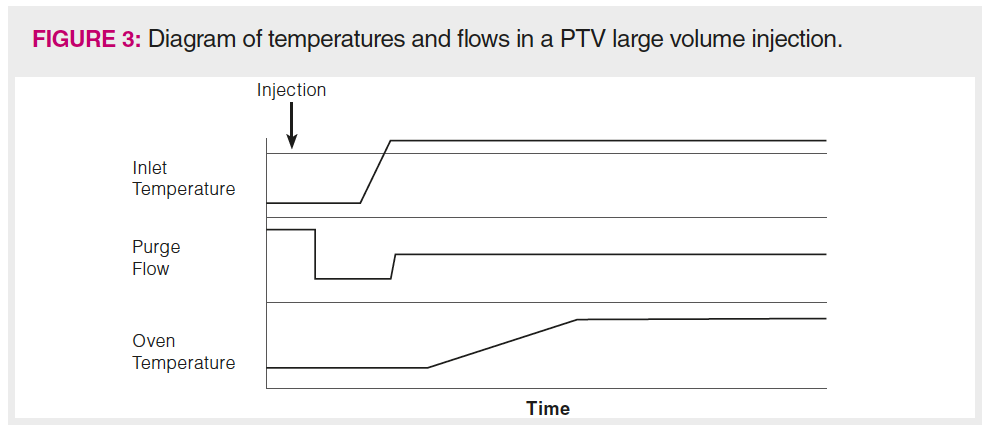
If a PTV inlet can handle a single injection of 100 µL, then why not inject more? It is actually possible to inject samples up to millilitres (yes, mL) using a PTV inlet by taking advantage of the packed liner, the cooled inlet and the vapour pressure of the solvent. A diagram of the process is shown in Figure 4. Consider each injected sample as an aliquot. Prior to the run, the inlet and column oven are cooled, and the purge flow through the inlet liner is high. With the inlet cooled and in its solvent vent mode, the solvent evaporates out the vent once the sample is injected. Once most of the solvent has evaporated, another aliquot can be injected. The solvent evaporates, leaving the analytes adsorbed in the packed liner. If this process is repeated 10 times using a 100 µL syringe, a 1000 µL sample has been injected. After the final injection and solvent venting, the solvent vent valve is closed, flow goes through the column, the inlet is heated, and the analytes are transferred to the column as in a splitless injection. In method development, the timing of the injections with the solvent vent flow rate must be carefully optimized. If all of the solvent is evaporated at any point, the vapour pressure of the analytes and the high solvent vent flow rate may cause some of them to desorb out through the solvent vent and be lost. This capability allows a PTV inlet to be the transfer device in on-line LC–GC (9).
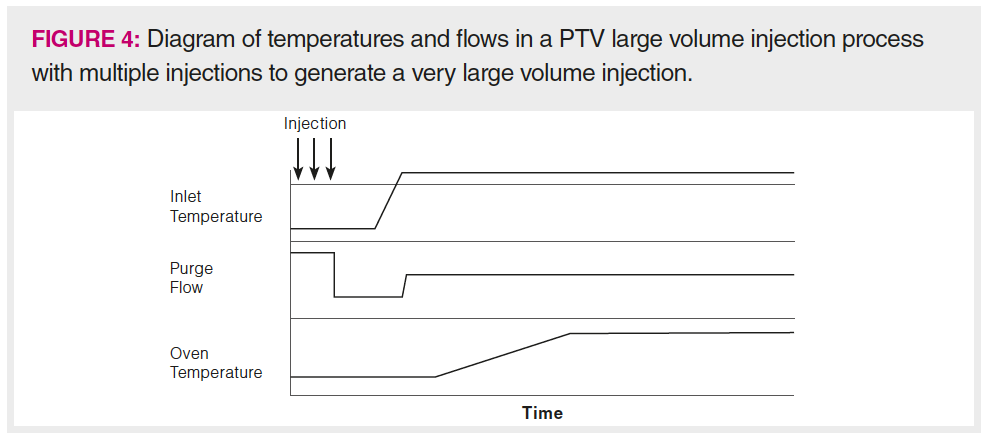
A cooled inlet with large volume injection capability, combined with a robotic auto‑sampler (a “rail”), offers many intriguing possibilities for automated on-line sample preparation and injection. Since the inlet is cooled, exchanging liners and performing maintenance is much faster than with heated inlets. Simply remove the top nut, and replace the septum and liner. No extra cooling and subsequent heating and equilibration, which are time consuming, are required. This is especially useful for laboratories that run “dirty” samples requiring inlet maintenance often.
Further, the top nut and seal can be configured to allow the inlet to be opened, and the inlet liner exchanged automatically. This is termed automatic liner exchange, and it opens up several opportunities. A PTV inlet with automatic liner exchange can double as a pyrolysis or thermal desorption unit. Samples can be loaded directly into the inlet liners either on a rail-type auto‑sampler, or on a separate instrument. Automated liner exchange is then used to load each inlet liner into the inlet, one at a time, for analysis. The PTV inlet is then heated to desorb analytes into the column. Most PTV inlets can rapidly heat to 500 °C or more, providing some capability for pyrolysis as well as thermal desorption.
We close with some questions and discussion points that you should explore with your vendor when considering a cold inlet.
- How are they equipped to support and provide method development assistance? Especially with PTV inlets, there are method development considerations that most gas chromatographers have not learned. Who will be providing technical support and how available will they be?
- Is this their own inlet, or is it provided by a third party? If a third party vendor provides the inlet, you may wish to work with the third party directly for purchasing the inlet and associated sampling devices, such as a rail auto-sampler.
- It is common to pair a PTV inlet with a rail-type autosampler. Be sure to discuss technical support and maintenance for the rail and the inlet in addition to the GC. Most likely, these will be additional operating costs.
In my opinion, if a cold inlet is not a “must have”, it is a “must consider” for any GC purchase today, and is worth considering for a retrofit. By reducing the possibilities for discrimination and other problems associated with traditional heated inlets, the extra upfront cost and learning time is more than offset by the greater capabilities and reduced troubleshooting.
References
- N.H. Snow, LCGC Europe 31(7), 378–384 (2018). http://www.chromatographyonline.com/split-splitless-and-beyond-getting-most-your-inlet
- J.V. Hinshaw, LCGC Europe, 20(12), 626–631 (2002). http://www.chromatographyon-line.com/split-decision-1
- K. Grob, Split and Splitless Injection for Quantitative Gas Chromatography: Concepts, Processes, Practical Guidelines, Sources of Error (John Wiley & Sons, New York, 2007).
- W. Vogt, K. Jacob, and H.W. Obwexer, J. Chromatogr. A. 174, 437–439 (1979).
- W, Vogt, K. Jacob, A-B. Ohnesorge, and H.W. Obwexer, J. Chromatogr. A. 186, 197–205 (1979).
- K. Grob, H-G. Schmarr, and A. Mosandl, J. High Resolut. Chromatogr. (now Journal of Separation Science) 12(6) 375–382 (1989).
- “Sample Introduction in Capillary Gas Chromatography” GL Sciences, https://www.glsciences.eu/optic/gc-injections-manual.pdf, accessed Jul. 3, 2020.
- “Large Volume Injection in Capillary Gas Chromatography” GL Sciences (accessed July, 2020). https://www.glsciences.eu/optic/LVI-training-manual.pdf
- A. Apedo and N.H. Snow, LCGC Europe 32(11), 600–610 (2019).
Nicholas H. Snow is the Founding Endowed Professor in the Department of Chemistry and Biochemistry at Seton Hall University, and an Adjunct Professor of Medical Science. During his 30 years as a chromatographer, he has published more than 70 refereed articles and book chapters and has given more than 200 presentations and short courses. He is interested in the fundamentals and applications of separation science, especially gas chromatography, sampling, and sample preparation for chemical analysis.His research group is very active, with ongoing projects using GC, GC–MS, two-dimensional GC, and extraction methods including headspace, liquid–liquid extraction, and solid-phase microextraction. Direct correspondence to: amatheson@mjhlifesciences.com
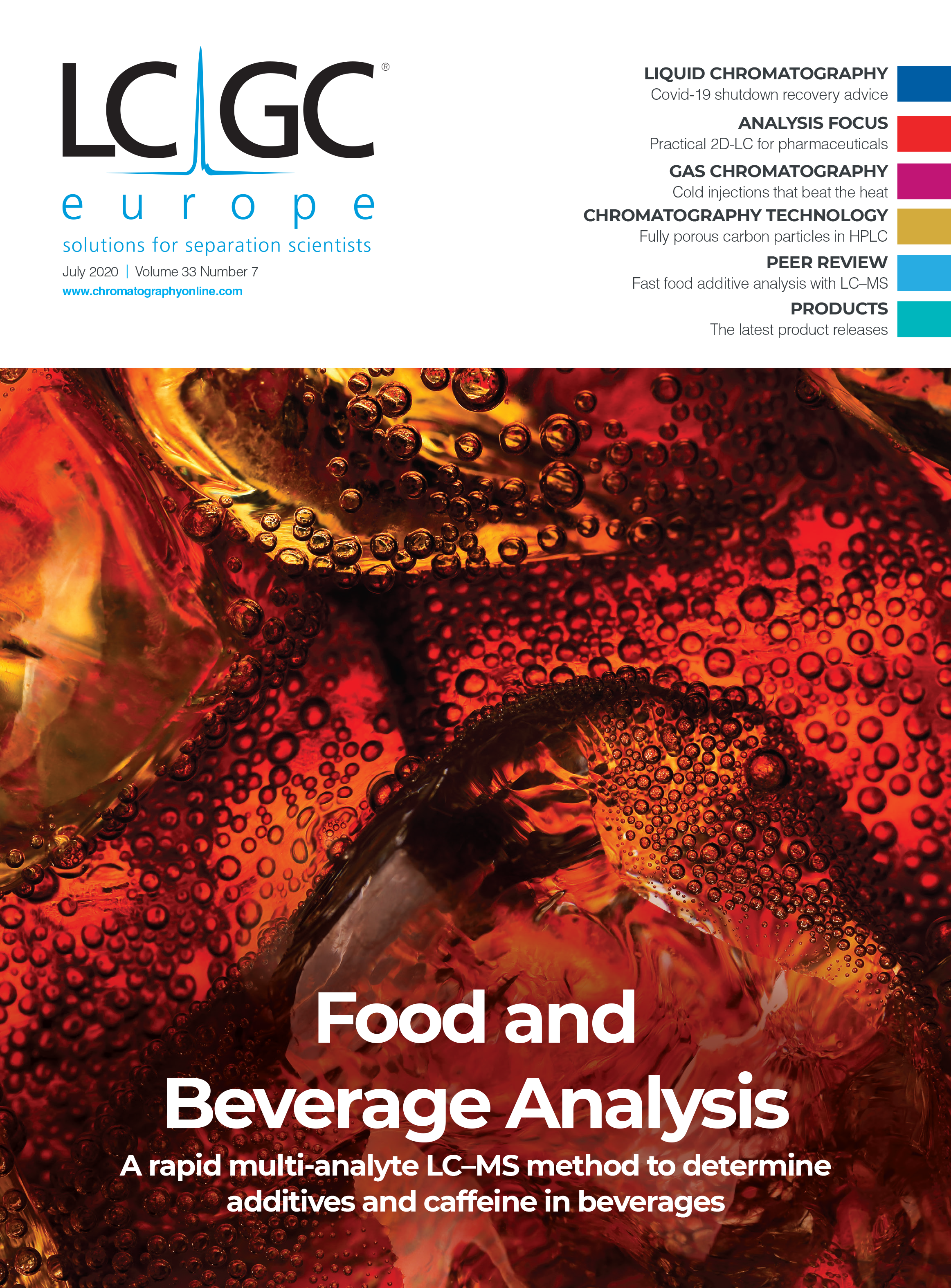
New Study Reviews Chromatography Methods for Flavonoid Analysis
April 21st 2025Flavonoids are widely used metabolites that carry out various functions in different industries, such as food and cosmetics. Detecting, separating, and quantifying them in fruit species can be a complicated process.
University of Rouen-Normandy Scientists Explore Eco-Friendly Sampling Approach for GC-HRMS
April 17th 2025Root exudates—substances secreted by living plant roots—are challenging to sample, as they are typically extracted using artificial devices and can vary widely in both quantity and composition across plant species.
Sorbonne Researchers Develop Miniaturized GC Detector for VOC Analysis
April 16th 2025A team of scientists from the Paris university developed and optimized MAVERIC, a miniaturized and autonomous gas chromatography (GC) system coupled to a nano-gravimetric detector (NGD) based on a NEMS (nano-electromechanical-system) resonator.

.png&w=3840&q=75)

.png&w=3840&q=75)



.png&w=3840&q=75)



.png&w=3840&q=75)








